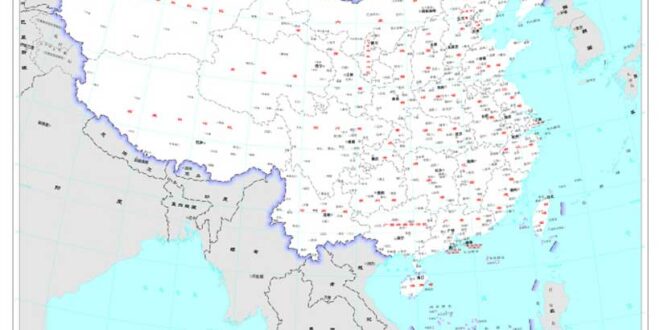China has released an updated map of its territory on August 28, 2023, that included its contested claims on the western border with India, the South China Sea and Taiwan. The “2023 edition” of its standard map was put up on the website of the cartographic service hosted by the Ministry of Natural Resources of the People’s Republic of China, during the so-called “National Mapping Awareness Publicity Week”. The Chinese state media adds that the map has been compiled based on “the drawing method of national boundaries of China and various countries in the world”. These claims, per se, is nothing new. But the timing of its release signals an impeding process of diplomacy and the season of summits is already on.
Among the territory included in the updated edition of map is the Indian state of Arunachal Pradesh, China’s long-time claim as the southern part of Tibet, and Aksai Chin, the arid northern extension of Ladakh occupied by China since the end of the 1962 Sino-Indian War. Another peculiar feature of the map is the presence of a “ten-dash line” around the South China Sea (nine dashes) and the entire island of Taiwan (the tenth dash), which also includes several small islands and islets claimed by Southeast Asian countries such as Vietnam, Philippines, Brunei, Malaysia and Indonesia.
The South China Sea and the Taiwan Strait happen to be a crucial arena of geopolitical competition between China and the United States, particularly in the past two to three decades. Both countries frequently conduct naval exercises in the region, which contributes to raising the threat perception levels and spiralling sense of insecurity on both sides. India and Southeast Asia, lying closer to China’s territorial and maritime borders, are economically dependent on China, despite the prevailing disputes in territorial perceptions. At the same time, the economies of the United States and China are closely interlinked and there is the added global technological rivalry between the two economic superpowers.
A border standoff yet to be fully diffused
The armed forces of India and China have held nineteen rounds of military-level talks along the Ladakh-Tibet border so far, ever since the fatal Galwan incident of June 2020. It was aimed at resolving the outstanding issues pertaining to the Line of Actual Control (LAC). The last meeting in the series was held on 14 August 2023, which turned out to be devoid of any major breakthrough. However, parallel diplomatic engagements are taking place at different levels, with the most recent one being at the leaders’ level. Chinese President Xi Jinping and Indian Prime Minister Narendra Modi briefly interacted during the 2023 summit of the BRICS nations (Brazil, Russia, India, China and South Africa) held in Johannesburg, South Africa, ten days after the last military-level talk.
During a press interaction at the BRICS summit, India’s Foreign Secretary stated, “The Prime Minister underlined that the maintenance of peace and tranquillity in the border areas and observing and respecting the LAC are essential for the normalisation of the India-China relationship”, a stance that is repeated by the Indian side at multiple forums. On the other hand, the statement from the Chinese side read, “President Xi stressed that improving China-India relations serves common interests of the two countries and peoples … The two sides should bear in mind the overall interests of their bilateral relations …”, emphasising on “overall ties”.
The aforementioned mismatch of focus of bilateral statements between the Indian emphasis on the “border issue” as the root cause of inability to improve ties and the Chinese call to look at “overall ties” is a recurring phenomenon of all bilateral-level interactions between India and China for more than three years now. In effect, the bilateral ties remain cold. President Xi and Prime Minister Modi have met twice since the standoff began in mid-2020. Earlier in 2022, the two leaders briefly addressed the border standoff on the sidelines of the G20 summit in Bali, Indonesia. Both leaders will meet again in September this year in New Delhi for the 2023 G20 leaders’ summit.
Differing nature of regional rivalry
While China’s strategic competition with India is regional in nature, the same with the United States is global. There are no direct territorial disputes between Washington and Beijing. But the U.S. alliance network in Asia brings Washington into to the geopolitical picture. Many of the regional allies of the U.S. happen to have territorial disputes with China, particularly Japan and the Philippines. This poses a serious challenge to completing China’s aspiring regional hegemony. However, there have been several attempts by the Biden administration in the U.S. to mend ties with China, as exemplified by the high-profile visits from the U.S. to China in 2023, including U.S. Foreign Secretary Antony Blinken, Treasury Secretary Janet Yellen, Special Climate Envoy John Kerry, and most recently, Commerce Secretary Gina Raimondo.
China’s recent double down on its territorial claims and cartographic bellicosity, particularly its sharper rhetoric on Taiwan, poses a serious threat to regional security in Asia, particularly since President Xi came to power in China in 2012-13. Beijing opposes interactions between Taiwan and the state officials of other countries as it considers Taiwan as part of its territory. Despite this, Taiwanese President Tsai Ing-wen met withU.S. House Speaker Kevin McCarthy in April, this year, and Vice-President William Lai made a low-key stopover in the U.S. earlier in August, this year. In response, Beijing vowed to fight “separatist forces” in Taiwan and strongly condemned both the visits. Last year, the Chinese People’s Liberation Army (PLA) conducted a massive show of strength following U.S. House Speaker’s visit to Taiwan.
Despite this geopolitically sensitive turn of events, diplomacy at bilateral and multilateral levels continues unabated. The U.S. Secretary of State Antony Blinken met with Chinese President Xi Jinping during his visit to Beijing in June 2023 and engaged in “candid talks”. He was the first U.S. top diplomat to meet the Chinese leader since 2018. Following the visit, Secretary Blinken said, “direct engagement and sustained communication at senior levels is the best way to responsibly manage our differences and ensure competition does not veer into conflict. I heard the same from my Chinese counterparts.”
During the talk with Secretary Blinken, President Xi stressed that “major-country competition does not represent the trend of the times, still less can it solve America’s own problems or the challenges facing the world. China respects U.S. interests and does not seek to challenge or displace the United States. In the same vein, the United States needs to respect China and must not hurt China’s legitimate rights and interests. Neither side should try to shape the other side by its own will …”
Coming back to the case of India and China, two large economies representing the Global South, otherwise cooperate via multilateral groupings such as the BRICS and the Shanghai Cooperation Organisation (SCO) which generally have tendency to counter the hegemony of the West-led global institutional order. However, both countries appear to be entangled in a security dilemma, characterised not only territorial disputes, but a basic lack of mutual trust. At the same time, India’s relations with the United States are at an all-time high with India’s participation in U.S.-led groupings such as the Quad and the Indo-Pacific Economic Framework for Prosperity (IPEF), which maintains a counter-China character.
Both the Presidents of China and the United States are scheduled to arrive in New Delhi, India, for the 2023 G20 summit in the second week of September, while India treads a skilfully balanced path of engaging all major players without an excessive tilt to either side and continues its thin line approach in diplomacy. Moreover, the military stand-off in Galwan continues to be the single-most factor that impedes a possible détente between the two major Asian economies. Considering all these, the new edition of China’s map can only be read as untimely and definitely not conducive to the process of bilateral, regional and multilateral diplomacy that is underway, particularly when it comes to mending its withering ties with India, the United States and Southeast Asian countries.
 Geostrategic Media Political Commentary, Analysis, Security, Defense
Geostrategic Media Political Commentary, Analysis, Security, Defense





